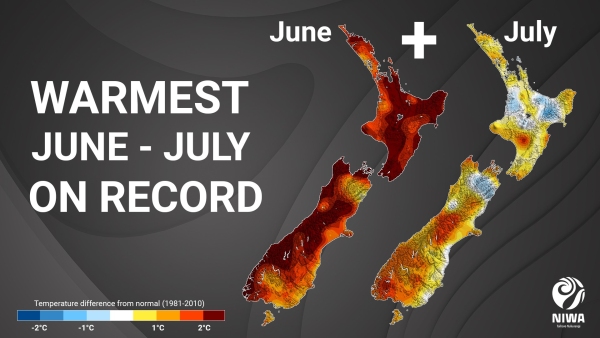New Zealand has just experienced its warmest June and July since records began in 1909 and – with one month to go - is on track for its second successive warmest winter on record.
Data from NIWA’s Seven Station temperature series shows that the temperature for the past two months was an extremely high 1.53ᵒC above the long-term average.
NIWA meteorologist Ben Noll says the previous record was 1.15˚C above average for June and July in 2016.
“There have been a number of factors which have contributed to the warmer temperatures. Air pressure has been higher than normal in the east so far this winter which has brought more northeasterly winds to New Zealand bringing warmer air from the sub-tropics.”
Sea temperatures around the coast have also been warmer than average, modifying colder air masses tracking towards New Zealand.
Mr Noll also said the Southern Hemisphere polar vortex above Antarctica has been stronger than normal. “This helps keep filaments of frigid air tucked away deep in the Southern Ocean.”
Atmospheric patterns have also leaned towards a La Niña-like direction, which tends to produce warmer conditions in the Southwest Pacific. Another climate driver in the Indian Ocean, called the Indian Ocean Dipole, developed during July and played a role in the atmospheric river that brought flooding to the Buller District as well as extra warmth and humidity.
Meanwhile, the warmer temperatures have resulted in more rain and less snow at lower elevations where rain has played havoc with some ski fields.
Hydrological forecaster Dr Jono Conway said most of the NIWA snow monitoring stations between 1800 and 2000 m elevation were experiencing average or above average snow levels for the time of year but sites at lower elevations had little or no snow. Apart from sites in Canterbury that received a large dump of snow at the tail end of the May flood event, most of the snow has come from a few big events in early- to mid-July.
“The warm temperatures have been causing the precipitation to fall as rain at lower elevations, which makes it very difficult for ski fields with bases at lower elevations, particularly club fields with no snow making.”
July in particular featured above or well above normal rainfall in the interior and western South Island, with Mt Cook recording 146% of its monthly normal rainfall and Arthur’s Pass on 181%.
Monthly temperatures were 1.7˚C and 1.9˚C above average, respectively, illustrating that the rain/snow zone sat at a higher altitude than normal.
Mr Noll said with the June and July temperatures tracking so far above average, this winter had a firm lead on last year’s figures.
“This is consistent with our expectations. In the background, the long-term tailwind of climate change continues to churn. Of the seven warmest June and Julys, six have occurred since 2000,” Mr Noll said.
For the year to the end of July 2021 ranks as the sixth warmest on record.


